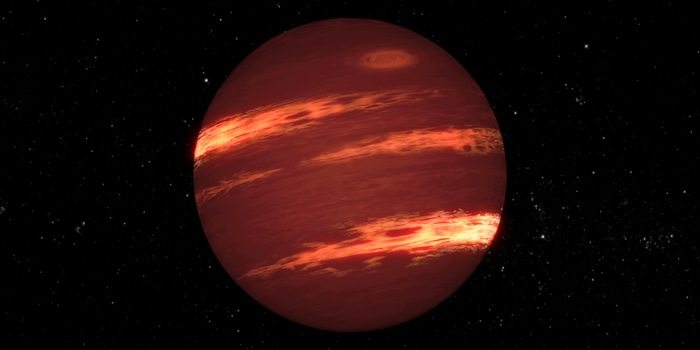
An exoplanet as a border crosser
HD206893c is a special celestial body: in terms of size, it could lie exactly on the border between an exoplanet and a brown dwarf.
What separates a planet from a brown dwarf? According to the definition, the boundary between the two is around 13 Jupiter masses: If this is exceeded, the fusion of deuterium in the interior can begin, which is characteristic of brown dwarfs. A team led by Sasha Hinkley from the University of Exeter has observed a celestial body 130 light-years away that could lie precisely in this border area: HD206893c has 12 to 13 Jupiter masses, while at the same time shining so brightly that deuterium is likely to be fusing in its interior, the team reports in a study on the ArXiv.
The HD206893c, which is still listed as an exoplanet, is located in a system in which an actual brown dwarf called HD206893B orbits the common star. It has 28 Jupiter masses and takes 26 years to orbit, while the new exoplanet is significantly closer to its sun: in 3.5 astronomical units compared to the 9.6 of the brown dwarf. The celestial body was discovered using the Very Large Telescope (VLT) in Chile. It is one of the first directly imaged solar systems to include both an exoplanet and a brown dwarf, the astronomers write. The star has a known protoplanetary disc around it and was therefore considered a good candidate for the search for new extrasolar planets.
The mass of HD206893c is thus at the lower limit considered necessary for a deuterium merger. However, an analysis of the data from the HARPS spectrograph at the VLT showed that the exoplanet shines too brightly for its size and distance from the star: The luminosity almost corresponds to that of the brown dwarf, which is more than twice as massive. Consequently, the celestial body itself must have an energy source, for which only deuterium fusion would actually be an option.
In our Milky Way alone, 100 billion brown dwarfs are thought to exist: "failed" stars whose mass is not sufficient to ignite the nuclear fusion of hydrogen in their interior. They therefore only glow faintly and are also more difficult to observe than real stars. However, special specimens keep popping up among them. In 2021, for example, astronomers reported three brown dwarfs in space that rotate at top speed: They reach a speed of around 360,000 kilometres per hour at the equator. Faster is probably almost impossible.
Spectrum of Science
We are partners of Spektrum der Wissenschaft and want to make well-founded information more accessible to you. Follow Spektrum der Wissenschaft if you like the articles.
[[small:]]
Cover image: NASA/JPL-Caltech / Brown dwarfs (symbolic image) do not have enough mass to ignite nuclear fusion. A newly discovered celestial body lies exactly on the border between exoplanets and brown dwarfs.
Experts from science and research report on the latest findings in their fields – competent, authentic and comprehensible.